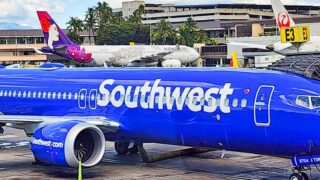As Hawaiian Airlines navigates its future, including the possibility of a merger with Alaska Airlines about which awaits word from the U.S. Justice Department, there are critical lessons to be learned. Those come from among other places, the recent unsuccessful merger attempt of JetBlue and Spirit Airlines.
Hawaiian faces significant challenges.
Spirit Airlines, about three times larger than Hawaiian by some measures, continues to grapple with a myriad of issues following their own failed merger attempt with JetBlue. Despite CEO Ted Christie stating that the airline isn’t considering a bankruptcy filing, Spirit’s situation remains precarious, and others, including Wall Street, have differing opinions.
That airline has been hit hard by the changing sands of travel demand, fierce competition, and, like Hawaiian, significant Pratt & Whitney engine recall issues that have grounded many of Spirit’s Airbus planes.
Financial analysts express concerns about Spirit’s ability to manage its debt. With its stock price dropping 80% since the merger failure, Spirit is fast-adjusting to save cash, including deferring aircraft deliveries and entering sale-leaseback deals.
Their experience underscores the importance of a robust, flexible, standalone business plan for Hawaiian Airlines that can withstand unknown challenges and market shifts. This is particularly relevant for them given the unknowns regarding being standalone or a part of Alaska Airlines going forward.
Learning from Its Past: Hawaiian Airlines.
The company’s own history is a storied one with regards to overcoming financial hurdles. The airline previously faced bankruptcy on two occasions, first in 1993 and again in 2003. Both times, Hawaiian implemented sweeping changes, from fleet modernization to operational restructuring, which helped it emerge far stronger.
Hawaiian is once again in troubled waters. According to its latest financials, the airline posted a net loss of $260 million in 2023, and more big losses of $138 million were already amassed in the first quarter of 2024. Hawaiian continues to have problems with its important international markets, intense competition, and with its A321neo fleet.
Differences Between the JetBlue-Spirit and Hawaiian-Alaska Mergers.
One key difference between the JetBlue-Spirit and Hawaiian-Alaska mergers is the level of route overlap. Hawaiian and Alaska have a much lower degree compared to JetBlue and Spirit. This makes the Hawaiian-Alaska merger potentially more appealing to regulators since it may not reduce competition as significantly.
Moreover, Alaska is set to maintain the Hawaiian brand while integrating operations under Alaska’s systems, customer service, and other infrastructure. This approach may greatly benefit Hawaiian Airlines’ customers by addressing Hawaiian Airlines’ operational weaknesses and providing a better, more streamlined guest experience.
In contrast, JetBlue planned to fully integrate Spirit, similarly to how Alaska handled its Virgin America deal.
Regulators were concerned about degrading low-cost fare availability since Spirit was theoretically known as a low-cost carrier, posing another significant factor in the DOJ rejection. In the Hawaiian-Alaska proposal, both airlines operate in largely different markets. That is the case with the exception of their twelve overlapping Hawaii routes.
Would DOJ object to certain overlapping routes?
Regulatory approval for the Hawaiian deal could potentially hinge, at least in part, on these overlaps. Regulators, like our commenters, may have concerns about any negative impact on Hawaii airfares. To address these concerns and facilitate the merger’s approval, DOJ may require necessary adjustments to the routes flown.
The pending merger is a potential lifeline for Hawaiian Airlines.
If successful, this deal will provide the scale and resources needed to compete effectively, and Alaska excels in this arena. However, Hawaiian, like Spirit, might face bankruptcy if the merger fails.
In the context of Spirit’s situation, Hawaiian, too, needs to ensure it has a robust standalone contingency plan. What that plan looks like isn’t clear, and we are loathe to conjecture about how it could evolve at this point in time.
Spirit’s current struggles speak to the risk of relying too heavily on a successful merger for financial viability. Hawaiian must therefore continue to streamline all operations, manage debt effectively, and find new ways to adapt its business model to remain competitive.
Hawaiian Airlines’ history offers valuable insights.
During its previous bankruptcy, Hawaiian implemented effective cost-cutting measures, successfully restructured debt, and greatly modernized its fleet. In hindsight, these steps were crucial in helping the airline survive. To ensure long-term sustainability, the airline needs to focus on maintaining operational efficiency, leveraging its unique brand identity, and exploring innovative revenue streams. To what degree that is possible this time around remains to be seen.
Without a doubt, the failed JetBlue-Spirit merger serves as a big red flag for Hawaiian Airlines. By learning from Spirit’s mistakes and drawing on its rich history of resilience, Hawaiian may be better able to navigate its financial challenges without regard to the outcome of its planned merger with Alaska Airlines.
How do you see the future of Hawaiian Airlines unfolding with or without an Alaska Airlines merger?
Get Breaking Hawaii Travel News






